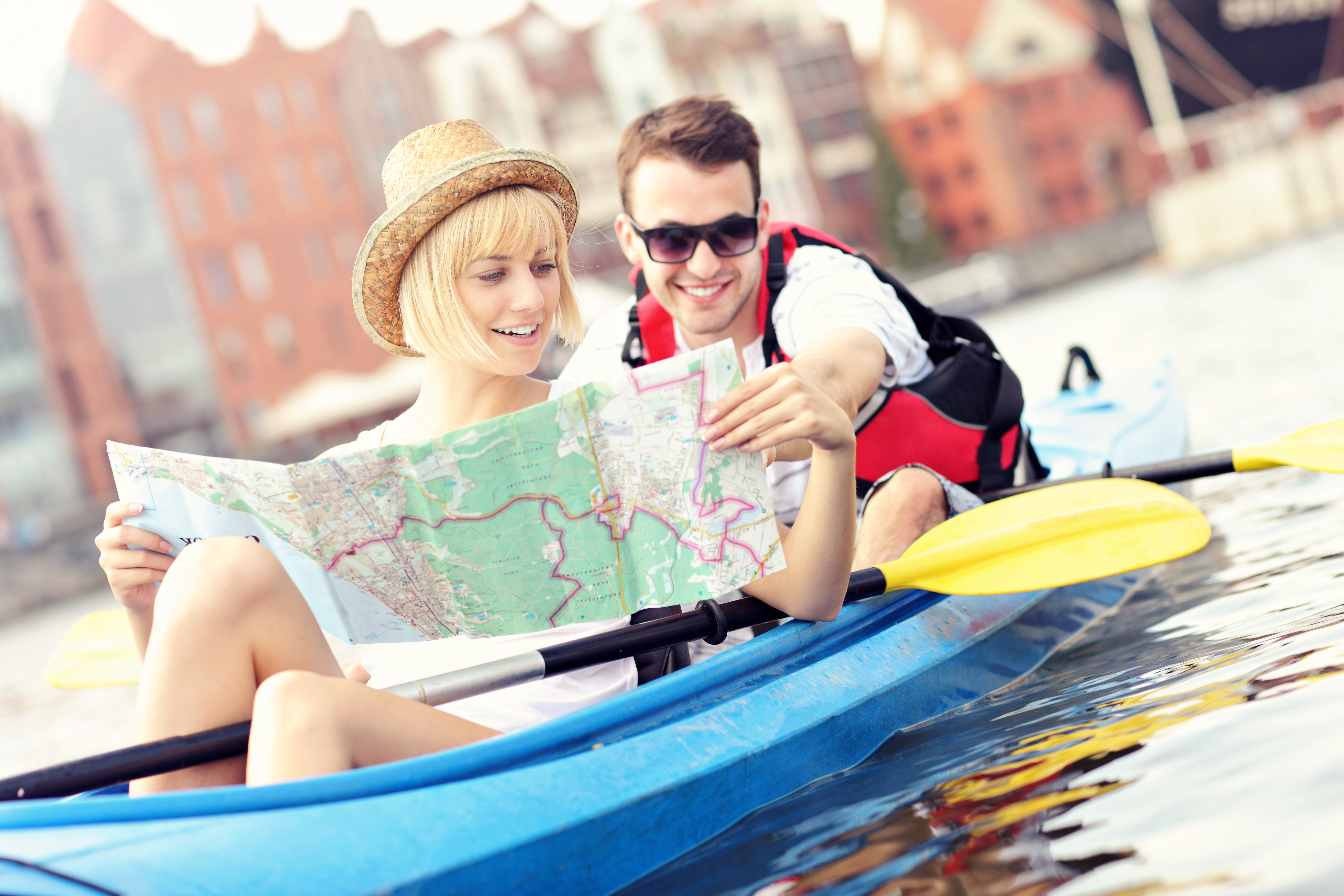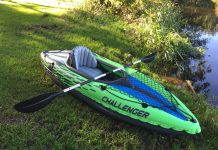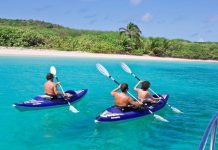
It’s 5:30am, and the sun has just begun to show its face as you pack up the Subaru and check the straps on your kayak. You’ve been reading and rereading every article and map you can find about the river you’re headed to, and the day has finally come.
You feel prepared, you’ve ticked every box, and now all that’s left to do is enjoy the adventure.
But how does one actually go about planning that perfect kayaking trip? Well, despite your pre-trip anxieties, it’s actually a lot easier than it may seem.
For kayakers of any level, this article is going to be your complete guide to planning a trip that’s nothing but smooth sailing from beginning to end.
Choose a Destination
It seems obvious but merits attention – you must first decide where to take a trip. And while you may have plans to kayak beautiful stretches of backcountry, you need to consider the conditions you’ll encounter and your paddling skill level.
Here are some factors to consider when selecting a destination and the pros and cons of the various water bodies.
Flat Water
Lakes and gentle rivers constitute flat water. Flat water is great for beginners and offers lower risk and difficulty.
In the case of lakes, you’ll not find any current, and the lake will need to be significant to merit a trip of more than one day.
Be careful if you’re paddling enormous lakes as the open space can often become quite turbulent and dangerous during storms or windy days. Even if you’re an experienced paddler, it’s always best to stick to the shore.
Whitewater
Rivers with sufficient flow rate and difficulty are not for beginner paddlers and they probably shouldn’t be navigated with a basic recreational kayak packed with camping equipment.
Whitewater kayaking is inherently dangerous, and you’ll want to take a few lessons to develop the skills and confidence before attempting any rapids.
Open Water
Open water includes large bodies of water such as lakes, oceans, and even paddling in the center of moderate-sized rivers.
Open water paddling can be dangerous due to the presence of hazardous water conditions as well as the long distance from the shore. This type of paddling is best avoided until an advanced level of training has been undertaken.
Choose Your Gear
You’re going to need different equipment for each of the above types of paddling trips. While this is not going to be an exhaustive look at all gear possibilities, it will serve to highlight some differences and key consideration points.
Kayak Choice
You’ll want a different size and style of kayak for each of the above destination types.
The length of your trip may also impact your decision on which type of kayak to bring along. In general, the following is true of longer kayaks:
- They track better (follow a straight path more easily)
- They are less maneuverable
- They provide more room for gear storage on long trips
It goes without saying that the inverse is true of shorter kayaks. Choose the length of your kayak based on your needs.
Here’s a quick overview of the kayaks you’ll likely consider for your trip:
Recreational Kayaks – a recreational, sit-in kayak with plenty of storage space is likely the best option for your trip – as long as you’re sticking to mostly flat waters. They offer the perfect blend of economy, stability, and general suitability for beginner paddlers.
Tandem recreational kayaks are readily available and will allow you to share the workload with a buddy.
Touring Kayaks – Ideal for paddling larger distances and for open water conditions. They perform well in waves and also include ample storage.
Whitewater Kayaks - short and agile, but have zero storage space and are only good for a day trip.
Paddle
Choosing a great paddle is a matter of preference and budget. Lighter weight is, almost invariably, better, and the best paddles are made from ultralight, near-future materials. Okay, maybe not NASA approved space material, but they often look that way.
In order of weight and quality, here’s a list of paddle materials from lightest to heaviest:
- Carbon Fiber
- Composite Laminates (wood, fiberglass, carbon fiber combinations)
- High-end Wood Paddles
- Plastic Economy-grade Paddles
Pay attention to the type of paddle you’re choosing as minor subtleties often greatly impact user experience. Factors to look for include:
- Blade shape
- Paddle length
- Feathering angle
See our comprehensive article on choosing the correct kayak paddle if you need some help.
Camping Gear

If you’re planning an overnight trip, you’ll need to pay attention to camping gear. In general, try to implement good hiking concepts to minimize gear weight and bulk – it all adds up.
Here are some critical pieces of camping gear you’ll need:
- Stove
- Ample water – for drinking, washing, and cleaning.
- Shelter – most likely a tent
- Sleeping bag or quilt
- Rain gear (poncho, rain jacket)
- Poop trowel
- General toiletries
- Dry bags
- High-energy, non-perishable food (our recommendations are below)
- Lighter / matches
This list is only a general guide, and you’ll have to consider your personal needs for several days in the bush (i.e. medication, eye wear, etc.).
There may be many more items you want to pack, but remember that every item you bring will weigh your kayak down, and you’ll have to paddle harder to keep momentum.
Safety Equipment
Even if you’re only on the water for the day, make sure you bring enough safety equipment for everyone in your group.
We’ve put together a comprehensive list of all essential kayak safety equipment, but at a bare minimum, you should bring along the following items.
- PFD – and make sure you wear it!
- Map and compass
- First aid kit
- Tow rope
- Mobile phone (stored in a dry bag)
- Flashlight
PRO TIP: If you’re paddling in the height of summer, don’t forget a wide-brim hat and sunscreen - there’s often no sun protection on the water.
This means good polarized glasses and shorts or pants which cover the tops of your legs when sitting and paddling. I like to paddle with an ultra-lightweight long sleeve polyester shirt to avoid sun exposure.
Pack Enough Delicious Food
Eating in the backcountry doesn’t have to be a chore, and it definitely doesn’t have to be bland.
However, that isn’t the green light to load up junk food that takes up lots of space but delivers little nutritional value (leave the chip and dip behind).
Here’s a great rule of thumb to follow as a guideline of how much food to carry on your next trip:
Daily Food Weight | Conditions |
|---|---|
1.5 lbs | Short trips, physical activity, warm conditions |
1.75 lbs | A great choice for most paddling trips |
2 lbs | Extreme activity and long trip length, cold weather |
Aim for high-calorie foods to replenish as much energy as you’re using – you’ll need fuel to sustain long days of paddling. Foods high in fat and carbs should be at the top of your list.
Here are a few high-calorie foods we recommend you pack:
- Fritos
- Nuts
- Nut Butters
- Olive Oil
- Snickers Bars
Who’s Coming Along on the Trip?

Ask yourself; would I keep my sanity if I was to spend six days in the wilderness with just me and this person (or group)?
It sounds silly, but trust me when I say that whoever accompanies you on your journey has the potential to make or break your trip.
You're pretty much going to be joined at the hip with this person (especially if you’re in a tandem kayak) for the duration of your trip, and you need to assess if you could comfortably get on with them throughout the ups and downs.
Small things like constant bathroom breaks, snoring, or not being a proficient paddler, can really get to you on a multi-day camping trip.
Sometimes man's best friend is all the company you’ll need. If you are planning on bringing a dog, make sure you follow basic principles for paddling with dogs, such as fitting them with their own PFD, to ensure you both remain safe on the water.
Review LNT Paddling Guidelines
LNT stands for Leave No Trace and seeks to provide a framework of suggestions by which backcountry travelers can plan and execute trips in a manner which minimizes environmental impact.
These are the seven LNT Principles:
- Plan ahead and prepare
- Travel and camp on durable surfaces
- Dispose of waste properly
- Leave what you find
- Minimize campfire impacts
- Respect wildlife
- Be considerate of other visitors
As you can see, it makes a lot of sense to abide by the LTP principles and leave the countryside in the same (or better) condition as you found it. Don’t be a douche and let others enjoy the same experience you did.

Leave nature as beautiful as you found it
Plan Your Daily Mileage
If you’ve never been out before, you might have a hard time guessing how far is reasonable to paddle in a single day. Let me save you from planning issues and provide the following rough guidelines for paddling distances for beginners:
One full day of paddling:
- Flat water (no current): 10 - 15 miles
- Flat water (river): 15 +- miles
- Open Water: 10 – 15 miles
- Whitewater: Contact a guide or outfitter
These are ballpark numbers and it is totally possible for a beginner paddler to travel 30 miles or more in a single day. To get started, however, it’s important to keep reasonable expectations, so try a few day trips with these distances in mind and then readjust your targets as your capabilities and experience grow.
Logistics Planning
There are several important pre-trip considerations for logistics. One which can sometimes be irritatingly difficult to solve is transportation.
In a nutshell; how will you get back once you’re done paddling?
Transportation
Common practice when paddling with a partner is to have one person leave a vehicle at the destination, and then carpool to the put-in. Then you’ll paddle to the destination and use one vehicle to get back to the other.
Another suggestion – which suits when traveling alone – is to enlist the help of the local canoe livery of the river you’re paddling. The liveries usually offer transportation to or from your start or destination. Call around to see what the best rates may be.
Maps and Camping
You may have a hard time finding reliable, accurate, and up to date maps for your river section. Sometimes there are none!
Again, start by calling the local liveries and doing a quick Google search. This should turn up plenty of information. If not, you may need to ask the locals if they can suggest any resources or any names of people who may know the information you need.
Camping can be difficult on river sections where private property crowds the shoreline. Good forethought here will save you from issues. If all else fails, try pulling off the river and asking politely if someone would mind if you put a tent in the corner of their property overnight.
Permits
Be sure to check with the governing agency of the river you’d like to travel to make sure permits are not needed. If they are, make the appropriate plans.
Keep in mind that some protected waterways have unique rules such as Wild and Scenic Waterways in the United States.
If you’re bringing your fishing rod along for the trip, fishing rules and regulations need to be followed. Violating these rules can leave you with a hefty fine and many law enforcement agencies will confiscate your equipment - including your kayak!
Conclusion
Have fun out there on your next trip and be sure to follow the necessary steps to keep yourself healthy and safe in the backcountry.
And remember to incorporate good LNT practices to avoid negatively impacting the river for future paddlers!
If you have remaining questions or cannot find a good solution to an issue you may encounter in planning your next kayaking trip, do not forget that local kayaking outfitters and liveries are almost always the best resource for up to date information on the section of river you’re planning.
As an Amazon Associate, we earn from qualifying purchases. This is without any additional costs for the buyer but does support us in maintaining our website.



